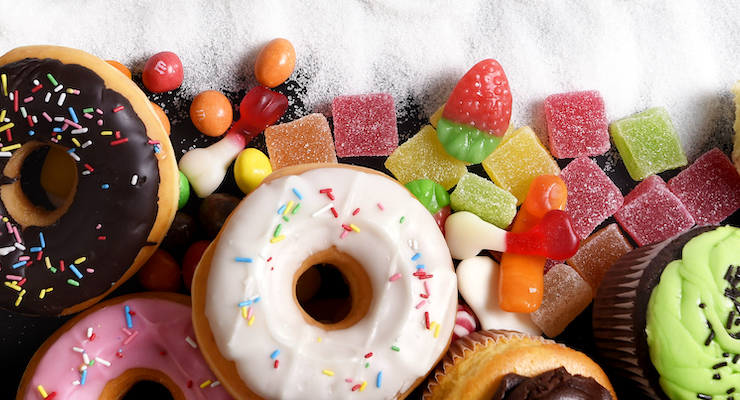Mike Montemarano, Associate Editor 03.19.21
Added sugars in a handful of forms have long appeared in a variety of foods and beverages, and the high calorie content of sugar is linked to excessive weight and obesity, as well as associated metabolic diseases. According to a study at the University of Zurich in Switzerland, a country where citizens consume and average of more than 100 grams of it every day, habitual consumption of even moderate amounts of added sugars are able to increase fat synthesis in the liver, possibly contributing to the risk of developing diabetes and non-alcoholic fatty liver disease (NAFLD).
Compared to prior studies, which found significant risk only in high amounts of added sugars, the results of the most recent study conducted on participants at the University Hospital Zurich (USZ) show that the amount of sugar required to double fat synthesis in the liver may actually be more moderate – around 80 grams daily.
“The overactive fat production continues for a longer period of time, even if no more sugar is consumed,” lead author Philipp Gerber, of the Department of Endocrinology, Diabetology, and Clinical Nutrition, said.
The clinical trial enrolled 94 healthy young men, who, over a period of seven weeks, consumed a drink sweetened with different types of sugar each day, while a control group abstained from the experimental sugary drinks. The drinks contained either fructose, glucose, or sucrose. The researchers then used tracers (labeled substances that can be traced as they move throughout the body) to analyze the effect of the sugary drinks on lipid metabolism.
The participants didn’t consume more calories than they did at baseline, the authors said. In fact, many consumed less calories from other sources due to an apparent satiety that the sugary drink provided.
Nevertheless, the researchers observed a boost in liver fat synthesis among the participants drinking sugar.
“The body’s own fat production in the liver was twice as high in the fructose group as in the glucose group or the control group – and this was still the case more than 12 hours after the last meal or sugar consumption,” Gerber said. Particularly surprising was that the table sugar people most commonly consume, sucrose, boosted fat synthesis slightly more than the same amount of fructose, which runs contrary to previously-held belief that fructose was most likely to cause such changes.
Increased fat production in the liver is a significant first step in the development of common diseases such as fatty liver and type 2 diabetes, the authors said. For these reasons, the World Health Organization recommends limiting daily sugar consumption to around 50 grams, but considers 25 grams ideal.
“But, we are far off from that mark in Switzerland,” Gerber said. “Our results are a critical step in researching the harmful effects of added sugars and will be very significant for future dietary recommendations.”
Compared to prior studies, which found significant risk only in high amounts of added sugars, the results of the most recent study conducted on participants at the University Hospital Zurich (USZ) show that the amount of sugar required to double fat synthesis in the liver may actually be more moderate – around 80 grams daily.
“The overactive fat production continues for a longer period of time, even if no more sugar is consumed,” lead author Philipp Gerber, of the Department of Endocrinology, Diabetology, and Clinical Nutrition, said.
The clinical trial enrolled 94 healthy young men, who, over a period of seven weeks, consumed a drink sweetened with different types of sugar each day, while a control group abstained from the experimental sugary drinks. The drinks contained either fructose, glucose, or sucrose. The researchers then used tracers (labeled substances that can be traced as they move throughout the body) to analyze the effect of the sugary drinks on lipid metabolism.
The participants didn’t consume more calories than they did at baseline, the authors said. In fact, many consumed less calories from other sources due to an apparent satiety that the sugary drink provided.
Nevertheless, the researchers observed a boost in liver fat synthesis among the participants drinking sugar.
“The body’s own fat production in the liver was twice as high in the fructose group as in the glucose group or the control group – and this was still the case more than 12 hours after the last meal or sugar consumption,” Gerber said. Particularly surprising was that the table sugar people most commonly consume, sucrose, boosted fat synthesis slightly more than the same amount of fructose, which runs contrary to previously-held belief that fructose was most likely to cause such changes.
Increased fat production in the liver is a significant first step in the development of common diseases such as fatty liver and type 2 diabetes, the authors said. For these reasons, the World Health Organization recommends limiting daily sugar consumption to around 50 grams, but considers 25 grams ideal.
“But, we are far off from that mark in Switzerland,” Gerber said. “Our results are a critical step in researching the harmful effects of added sugars and will be very significant for future dietary recommendations.”




























